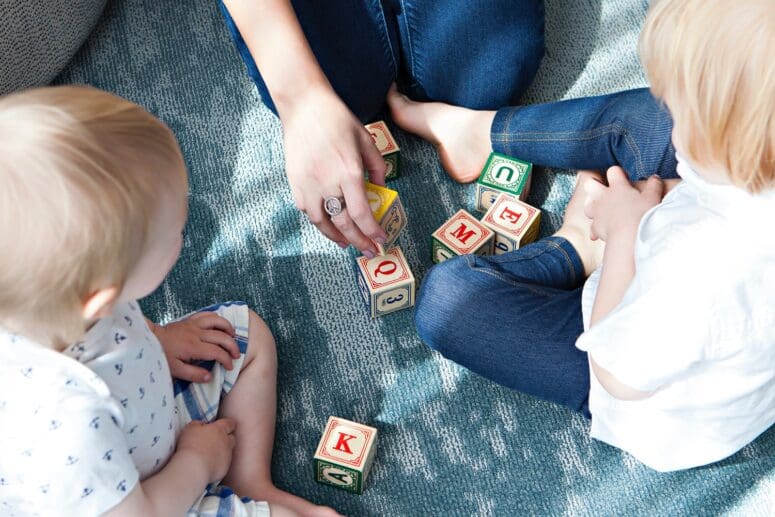Living In a Small House with Kids? How to Trade Up Without Busting Your Budget
- Published on
- 4-5 min read
-
 Christine Bartsch Contributing AuthorClose
Christine Bartsch Contributing AuthorClose Christine Bartsch Contributing Author
Christine Bartsch Contributing AuthorFormer art and design instructor Christine Bartsch holds an MFA in creative writing from Spalding University. Launching her writing career in 2007, Christine has crafted interior design content for companies including USA Today and Houzz.
Hiding out in the attic crawlspace for a little “me” time. Running late because you had to wait in line to use the bathroom. Constant jockeying for prime seating on the tiny sofa in the TV room during your family’s favorite shows.
Sounds like your life living in a small house with kids, huh? Well, it’s time for a fresh start in a larger home, but one thing is holding you back: money.
Raising a family is expensive. According to the U.S. Department of Agriculture, “a family will spend approximately $12,980 annually per child in a middle-income ($59,200-$107,400), two-child, married-couple family.”

And the average household spends just under $20,000 on housing expenses annually—which means a family of four is spending around $45,000 a year on their home and kids. Adding several hundred dollars a month in mortgage payments (not to mention the increase in property taxes, home maintenance expenses, and monthly utilities) might sound too expensive for your already tight finances.
But it doesn’t have to be—if you approach the process with a solid plan and a sound financial strategy. Let’s get you out of cramped quarters and into a more manageable living space. In 4 basic steps we’ll cover how to:
- Prioritize your family’s must-haves in the next house and identify opportunities to preserve the budget.
- Understand your current finances and property value with a “worst-case scenario” perspective to plan your next move conservatively.
- Put your home equity toward a sizable down payment with the help of a trusted advisor.
- Bargain shop for your next home and negotiate down on price and closing costs.
Step 1: Weigh your wants and needs for the next house
More space. That tops the list when you upgrade to a bigger house—but bigger isn’t better if the new home isn’t spacious in the right places. So before you go house hunting, evaluate where you need the extra space.
Do you want separate bedrooms for each of your kids? A second or third bathroom? A bonus room big enough to be converted into a playroom? A backyard with room enough for a swing set or batting cage?
However, “more space” is likely not the only item on your list of features you desire in your ideal family home. Add features like easy-clean surfaces and closed storage to keep things out of reach from curious toddlers.
Consider the floor plan, too, such as the benefits of having the master suite and your kids’ bedrooms on the same level. List architectural annoyances to avoid, like the trip hazards of sunken living rooms. Also think long term, like buying a single level, stairs-free home that will accommodate aging in place longer when you retire.
If you want it, list it—then rank them by order of need so you can separate your must-haves from areas where you can compromise.
Compromise is key when you’re buying a home on a fixed budget. Take school districts for an example.
Ask most agents and they’ll tell you that school districts are paramount in importance to home buying parents—so much so that they’re willing to get less house for more money just to live in the right district.
School districts are so important to parents that they even impact home values in the surrounding areas (homes are significantly more expensive in the best school districts).
However, school districts don’t need to dictate where you live if you’re willing to think outside the box for your child’s education. Districts only matter if you’re planning on sending your kids to public schools, and even then there are often multiple schools to choose from in one district.
Alternatives like charter and private schools aren’t restricted by district, so you can find one that’s near or on the way to your workplace. When you take school districts out of the equation, this opens up a lot more affordable family-friendly neighborhoods to go home shopping.

Step 2: Evaluate your current mortgage and existing home equity
How many years has it been since you first purchased your starter home?
If you bought it more than four or five years ago, chances are you’re a completely different person now, especially financially. As a first-time home buyer, you may have had more debt, a less-than-ideal down payment, or a lower credit score. You may even have a better job now with a higher income than you did when you took out your first mortgage.
All of these financial factors were taken into account when you took out your starter home loan. If you haven’t refinanced, then you’re still paying a mortgage written when you were in a weaker economic situation.
Essentially it boils down to this—while you may be happy with the current dollar amount of your existing mortgage payment, those dollars may not be working hard enough for you.
Sure, buying a bigger house is going to cost more than the value of your current house, but if you’re buying the new house from a stronger financial position, you’re going to get a bigger bang for your buck.
And don’t forget to factor in all your starter home’s increased value and all of the equity you’ve built up paying down your mortgage. Both will play a big role in increasing the size and price you can afford in a family home, as well as bringing down that monthly mortgage payment.
Just make sure to aim low rather than shoot for the stars with your equity expectations.
“I like planning for the worst case scenarios,” says Sidney Divine, founder of Divine Wealth Strategies. ‘Always assume the home will sell for less and always inflate the expenses of moving to the newer home so you can assess how you’ll fare in a worst case scenario and if there’s a little bit of wiggle room or not.”

Step 3: Determine potential proceeds from your home sale
If you purchased your home after the 2008 housing market crash, chances are you got a screaming deal on both the property price and the mortgage rate. Both of those facts work in your favor even though both interest rates and home prices are on the rise.
It all comes down to the down payment.
The bigger your down payment, the better. More money down means a smaller loan balance and a lower mortgage rate, which means more of your payment will go toward paying down the principal rather than wasted on interest.
“I have helped clients who have a 5% down payment put the proceeds from their starter home toward buying down their principal in a bigger home,” explains top agent Ben Swanson who ranks as one of the top 1% of agents in Mesa, Arizona.
“There’s a program that’s not a full refinance where they will recast and reamortize the entire loan. So they’ll have their 20% down payment and the mortgage insurance will fall off. I’ve done that with a couple of clients now and it has worked out really well.”
With a mortgage recast, you’re paying a lump sum toward your principal balance in exchange for lower monthly payments. This process reamortizes the loan, reducing the principal debt amount—however, it does not alter the interest rate at all.
In essence, you’re just increasing your down payment on the new home with the proceeds from your starter home sale after it sells. Since you’ll then owe less on the loan, you can pay less each month toward paying it off.
That’s why you need to add the proceeds from your home sale into the down payment calculations on your home purchase.
“It’s important to factor the down payment into calculating how much house you can afford,” advises Divine. “If you’ve built up enough equity, the proceeds from the sale of your current home can be used as part of the down payment for a new home.”
Of course, you won’t actually have access to that home equity until after your starter home sells—does that mean you can’t buy a new home until you sell your existing home?
Not necessarily.
There are actually home buying programs to help you use your existing home’s equity as part of the down payment, and pay off closing costs, too. And you’ll only have to move your family once, from your current home into the new one.
You just need to make sure you’re working with a top-notch agent who’s got great connections.
“It’s imperative that your agent works with a trusted loan officer who understands the programs that assist the seller with closing costs,” advises Swanson. “We can use those programs to buy down the rate to make the monthly mortgage payment a lot more affordable.”

Step 4: Find the right deal on your upsized house
The best way to find the right deal on your home purchase is to rely on the advice of your real estate agent.
An agent’s job is to help you figure out how much house you can afford, negotiate the sale price, ask the seller for concessions, and, most importantly, find a home you love.
One big mistake too many repeat home buyers make is buying above budget. This happens for two reasons:
Reason 1: Homeowners mistakenly think that pre-qualifying for a mortgage is the same as getting pre-approved. Pre-qualifying only gives you an idea of how much house you can afford—to find out how much a mortgage company is actually willing to lend you, you need to get pre-approved.
If you start house-hunting without that pre-approval, you may fall in love with a house that’s too expensive for your budget.
Reason 2: Home buyers become so fixated on fulfilling their ideal home wish list instead of on their finances—because they know they’re only going to buy a handful of houses in their lifetime.
Thankfully, if you’ve taken the first step of prioritizing your wants and needs, you’ll already have contingency plans on how different houses can fit into your budget and your lifestyle.
For example, you may be able to cross that “separate bedrooms for each child” off the list if you buy a home with a giant playroom where most of their books, toys and games can go. Then, when they outgrow their playthings, the space can be converted into another bedroom. You can even think outside the box and give your kids privacy early on by converting a walk-in closet into a cozy, magical bedroom.
Moving is an expensive undertaking, and it’s even more of a financial struggle when you’ve got little kids in tow.
But there’s no reason to suffer raising young kids in a too-small home when developing personalities, emotional meltdowns, and unpredictable teenage hormones are making your kids crazy and chaotic—especially when they’re living on top of one another.
Luckily, upgrading to a larger family home doesn’t have to bust your budget with proper financial planning, the right mortgage, and a savvy real estate agent who has experience helping families afford home upsizing.
